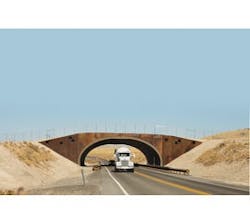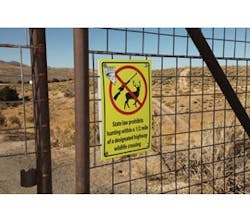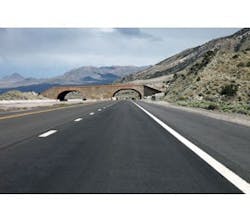TRAFFIC SAFETY: Unleashing the potential
Humans and wildlife interact in some form or another on a daily basis.
If you are one of the many people that enjoy viewing wildlife, sightings can be exciting, but when traveling at high speeds, close encounters can be dangerous or even fatal. In the 1990s, the number of vehicular accidents throughout the U.S. was relatively static, yet wildlife-vehicle collisions were on the rise. Consequently, transportation and natural resource agencies began working together to reduce the number of these types of collisions.
There are a variety of techniques used to minimize wildlife-vehicle collisions, but one that has grown in popularity over the past decade is the addition of wildlife fencing and crossing structures into highway infrastructure. Wildlife crossings can be as simple as a small culvert under the roadway designed for reptiles and amphibians, or structures can be as complicated as a bridge crossing over an interstate designed for large animals like deer and elk. Regardless of the type of crossing, the intent is to make the roadways safer by diverting wildlife away from motorist throughways while also reducing habitat fragmentation and increasing landscape connectivity.
Working together
Thousands of mule deer migrate biannually between summer and winter ranges fragmented by Nevada’s Rte. 93 and I-80. Photo courtesy of NDOT.
Nevada is one of many states that has integrated safety crossings into its transportation infrastructure and has documented the benefits of its investments. It all began in the mid 2000s when the Nevada Department of Transportation (NDOT) and the Nevada Department of Wildlife (NDOW) came together to address wildlife-vehicle collisions. A variety of animals had been involved in collisions throughout the state, including elk, bears, mountain lions, bighorn sheep and domestic livestock, but the majority of collisions involved mule deer. Since mule deer were the most common species involved in wildlife-vehicle collisions, and their populations had been struggling for many years, they became the focal species for Nevada.
During preliminary planning stages, several locations in northeastern Nevada were highlighted as probable sites for infrastructure adjustment. Based on wildlife-vehicle collision data collected by NDOT and the Nevada Highway Patrol, as well as expert opinion provided by NDOW, several locations on Rte. 93 and I-80, respectively, were identified as the highest priorities. Thousands of deer in this area migrate biannually between summer and winter ranges that are fragmented by both Rte. 93 and I-80. The choice was made to focus initial efforts on the Rte. 93 corridor in order to investigate the success of the structures before tackling the larger-scale projects that would be required to address I-80.
Since migratory species are known to exhibit strong fidelity to migration routes, pre-existing routes needed to be documented so that the structures and fencing were placed accordingly. Therefore, several mule deer were monitored with GPS store-on-board collars by NDOW. These movement data identified two primary migration routes that crossed Rte. 93, crossings which also correlated with the deer-vehicle collision data and were located at HD Summit and 10 Mile Summit, respectively. The highway at these summits passed through cut sections that were more conducive to the placement of overcrossings than undercrossings and were optimized based on the topography and available right-of-way. Although the focal species was mule deer, the goal was to provide a wide, open and natural transition that would encourage numerous species to utilize the crossings.
NDOT tried to adhere to several of the suggested goals and conclusions stated in the NCHRP Report 615, more commonly known as the “Evaluation of the Use and Effectiveness of Wildlife Crossings,” written by John Bissonette and Patricia Cramer. Among the goals were: (i) “incorporate wildlife mitigation needs early in the DOT/MOT programming, planning, and design process”; (ii) “combine several animal friendly mitigation methods such as wildlife crossings, fences, escape ramps, and gates, rather than relying on just one method”; (iii) “use conservation plans and connectivity analyses to inform the transportation programming, planning, and design process on where mitigation is needed and how it may be carried out”; (iv) “establish effective communication and collaboration among stake holders”; and (v) “incorporate wildlife crossing options into plans and schedules that can be accomplished (built) by the contractor(s) who will build these types of projects.”
From plan to execution
As planning efforts moved forward, it was evident that available information regarding overcrossings was limited. Several issues NDOT engineers faced were determining appropriate widths, grades approaching and exiting the structure, and visibility of the roadway below. Based on plans from previously constructed crossings in Canada and Europe, and limited available research, it was determined that an equivalent width-to-length ratio would provide sufficient area without requiring additional solid fencing or the construction of soil berms to limit the visibility of traffic passing under the structures.
The underpasses on Rte. 93 are made of large corrugated metal spheres that pass under the roadway. Partial road closures were required during installation. Photo courtesy of NDOT.
A number of factors contributed to the inside dimensions for the overpasses to meet both state and federal guidelines including careful attention given to the widths and heights of the minimum clearance envelopes. First, the Rte. 93 corridor is frequently used by oversized permit vehicles traveling through the state. Because there are no ramps or alternate routes, the structures had to accommodate even the largest vehicles requiring over-dimensional permits. Therefore, NDOT specified a minimum clearance envelope of 16 ft wide by 22 ft 6 in. high at the center of the structure. The second clearance envelope taken into consideration was calculated based on standard travel lanes and shoulders. For this two-lane highway, the minimum height is set at 16½ ft, but the required width at 10 Mile Summit and HD Summit varied 48 ft to 56 ft, respectively, based on variations in roadway features. Future truck-climbing lanes, minimizing the structural profile and construction duration also were considered.
In an effort to provide an economical structure that would blend with the surroundings and provide the required clearances, precast concrete arches were deemed advantageous from a design standpoint. With a very short design window, both overcrossings were designed using performance specifications for the structural elements to utilize the expertise of the arch manufacturers and allow them flexibility in the design. On previous precast arch projects, the NDOT required the use of standard mechanically stabilized earth (MSE) panels which may have limited the opportunities of the manufacturers to use their own wall systems and provide a more economical design. Learning from previous experience, we allowed more latitude regarding the use of oversized MSE wall panels and geosynthetic reinforcement.
Precast arches also were beneficial considering the remote location of the construction sites. Concrete unit prices have generally been higher in these locations because of the distance to the nearest suppliers. Although the footings were constructed using cast-in-place concrete, the amount of concrete delivered to the jobsite was minimized. Currently in Nevada, all precast bridge components are fabricated out of state, and concrete arches are most often supplied out of Utah or Idaho. Because the wildlife crossings were constructed at locations within a few hours’ drive of both Twin Falls and Salt Lake City, shipping costs could be controlled.
Construction of both overpasses had very few traffic impacts. All footings were constructed outside of the existing travel way behind temporary barrier rails. Temporary traffic stops were required during the erection of the arches, and several segments were installed during each closure. The contractors were able to erect all arch segments in only a few days and finish the walls and backfill without requiring traffic control. Lastly, to reduce the profile of the structures, minimal fill was placed above the arches and slopes were graded as flat as possible, limited in some areas by the available right-of-way.
In addition to the two overpasses, three underpasses were erected along with approximately 7 miles of wildlife fencing to funnel the animals to the structures. The three underpasses are large corrugated metal spheres that pass below the roadway. Each underpass is approximately 26 ft wide, 90 ft long and 20 ft tall. After installation, dirt was placed in the base of each sphere to create a natural pathway and was graded to match the natural elevation at the boundaries of the public right-of-way. All three underpasses have a minimum 20-ft x 12-ft clearance opening after all grading was completed. The wildlife fencing was connected to the entrance of each structure, between each structure, and extended approximately 1 mile beyond the outer structures, creating a continuous system at both summits. The fencing is 8 ft tall and is made of 121⁄2-gauge woven wire. Additionally, escape ramps were placed throughout the system.
Nevada built a large wildlife overpass on I-80 at Silver Zone Pass in the Toano Range. This is the largest structure in North America. Photo courtesy of NDOT.
Justifying the endeavor
After construction was completed, NDOT and NDOW wanted to investigate the project before making further investments. Therefore, the University of Nevada, Reno (UNR), was brought in to conduct post-construction research. The Tian Lab within the Department of Civil and Environmental Engineering investigated the economic benefits, while the Stewart Lab within the Department of Natural Resources and Environmental Science investigated the biological benefits.
The objective of the economic study was to identify if the improvements on Rte. 93 were justifiable. The analysis period included preconstruction data of wildlife-vehicle collisions from 10 years prior to the construction and two years after the completion. Utilizing a benefit cost analysis that incorporated various factors such as the cost of construction with those associated with wildlife-vehicle collisions, UNR calculated a benefit-cost ratio of 1.58 indicating the improvements were financially justified.
The objectives of the biological study were to determine which type of structure—overpass or underpass—was more effective and used more frequently by mule deer, and also to determine if the project improvements reduced deer-vehicle collisions. UNR used wildlife cameras to document movement activities during the biannual migratory periods. The results showed all of the crossing structures were used as soon as they were available and by a variety of species including domestic livestock, elk, pronghorn, coyotes, foxes and bobcats, but more than 90% of the crossings were made by mule deer. In the first four years, more than 35,000 successful crossings by mule deer were documented during migratory periods, 80% of which occurred at the overpasses. Behaviors indicated less reluctance to use an overpass when compared to the underpasses, but with time, they habituated to the underpasses and exhibited less hesitation. The number of deer killed in traffic collisions near 10 Mile Summit decreased 50% with each subsequent migration and have stabilized between zero to one after only the first three migrations. However, the number of deer killed at HD Summit did not stabilize as quickly. This indicated the improvements at HD Summit did not cover enough of the landscape, suggesting the movement corridor is much wider than originally thought. Therefore, NDOT is in the planning phases to add another underpass and additional fencing during the 2015 construction season.
With such positive economic and ecological benefits, Nevada continues to integrate wildlife crossings into its highway and interstate infrastructure. Several crossings are now in place throughout the state including the first crossing to remove horses from a busy highway as well as the largest overpass in North America (200 ft wide x 200 ft long) spanning five lanes of interstate traffic. The state continues to move forward with confidence on several crossing projects that are in the planning phases throughout all corners of Nevada. R&B



